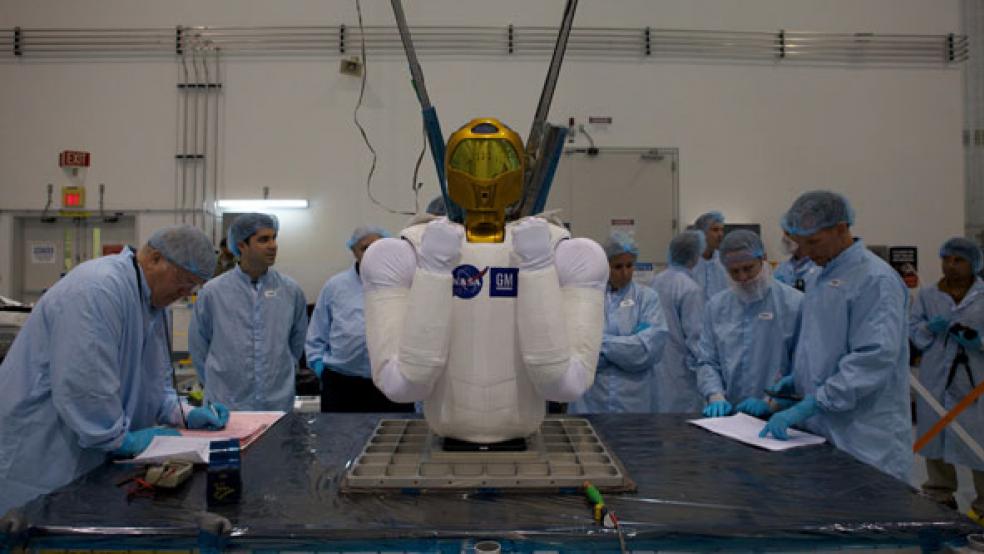Behind the lobby in iRobot's headquarters, a gaggle of small children and a few of their parents are getting a tour of the company's "Cool Stuff Room."
On display is some of the cool stuff the company has developed during its 25-year history, including its best-known product, the Roomba vacuum cleaner. You can also see a couple of versions of the PackBot, a robot used primarily by the military for bomb disposal, but one that is also employed by law enforcement. A few PackBots were deployed by police during the harrowing days following the Boston Marathon bombings in 2013.
Once a curiosity, robots like these are becoming increasingly mainstream. The rising popularity is reflected in the change in iRobot's neighborhood 20 miles west of Boston.
Related: One Profession Robots Haven't Cracked Yet
"When we moved to Bedford 10 years ago, we were the only robotics company within 150 miles," said Russ Campanello, iRobot's executive vice president of human resources and corporate communications. "Now there are probably 50 within 30 miles of us."
By 2025, a quarter of all jobs you can automate will be handled by robots, up from the current 10 percent, according to a Boston Consulting Group's report "The Shifting Economics of Global Manufacturing."

"It means a very substantial increase in productivity and it means we will be able to produce more at lower prices," said Hal Sirkin, senior partner and managing director at Boston Consulting Group. "We are thinking about a 16 percent drop in labor costs for manufacturing plants over this time period."
A key reason we are seeing faster adoption of robots is that they are cheaper. Those used in manufacturing once cost up to $250,000. Today there are some that cost under $40,000, like Rethink Robotics' Baxter. These robots are not only cheaper, they are also more advanced than their predecessors. They can do more difficult tasks and can be easily be reprogrammed to do different jobs.
"If you look at a very low end robot that might be doing some spot welding, it's about $8 an hour," said Sirkin. "It's somewhere between $20 to $25 an hour to do the same thing with a human being."
Related: Robots Take Caregiving to a Whole New Level
Spending on robots is seen rising to $67 billion by 2025 from an estimated $25 billion this year, according to Boston Consutling. Most of that spending is expected to be done by four industries—computer, electrical, transportation and machinery. The countries buying the majority of these robots will be those with higher labor costs. including South Korea, Japan, the U.S. and Germany. China is also a rapid adopter.
What this means to the future of the factory worker is unclear, Sirkin said.
At a single factory, you might see layoffs of lower paid, unskilled labor, he said. At the same time, that factory would have to hire more college-educated, highly paid workers to program and service the robots and manage the floor.
"But that is just the beginning of the story because what it allows countries like the U.S. to do is to bring back work from other places," said Sirkin.
Mixing robots with human labor would allow small and medium-sized businesses to produce more goods at a competitive cost here in the United States, he said, in turn creating jobs once lost to low wage regions like Asia.
Related: We're One Step Closer to Robots on the Battlefield
IRobot is not focused on making robots for manufacturing, but in the three markets it supplies, consumer, defense and security, and so-called telepresence, demand is so robust the 550 person firm has gone on a a hiring spree. It is adding workers in customer-facing roles, consumer marketing and hiring more engineers who account for half its workforce.
"Last year we hired almost 100 people," said Campanello. "This year we have plans to do the same."
Campanello said while the robotics market is "very hot" right now, the iRobot brand and 25-year history helps it recruit the workers it needs. Still, those workers can fetch a pretty steep price for their talents.
"In the robotics industry for sure there is more demand than supply," he said. "We are certainly competitive for every person we meet and for every talent area we compete for."
Campanello declined to say what the company would pay an entry level engineer, only that they would "have a nice life" with the starting salary, a salary that goes higher depending on past experience and additional advanced degrees.
This article originally appeared in CNBC.
Read more in CNBC:
Which colleges have the best return on investment?
Expect more volatility in oil: Exxon CEO
Home equity loans face new risk




